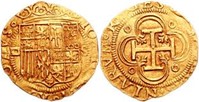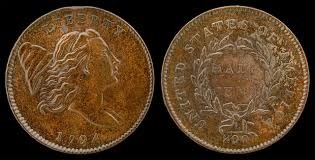Relics are fragments or objects that have survived from the past, and in the case of relics found in Cumberland County they are gold and silver coins, buttons, silver spoons, and cannonballs.
In 1897, Frank Nace, a farmer and miller in Middlesex, was ploughing a spot near his residence where a log cabin had once stood when he dug up a gold button. But not just any old button. It was a gold button about one and a half inches in diameter. Around the outer edge were the initials of the original thirteen colonies and in the center were the initials “G.W.”

Could it have been one of these buttons that were made to celebrate the Inauguration of George Washington? The local newspaper reported that “the supposition is that the relic is a button once owned by George Washington and lost by that hero whilst visiting the grandfather of the late James G. Blaine in the month of October 1794.”1 It is unlikely that the button belonged to George Washington, but it could have been purchased as a souvenir and owned by someone in the area, or it may have even been lost from the jacket on one of the thousands of men who gathered in Carlisle in October 1794 to march with Washington to western Pennsylvania to quell the Whiskey Rebellion.
A completely different kind of relic was found in December 1895, when workmen were excavating the cellar for Mrs. A. L. Beetem’s new house on West High Street. They found a silver spoon with the initials “P.B.M.” made by Carlisle silversmith George Hendel. The spoon belonged to Priscilla Boyd Murray who had lived in the house that had been torn down to build Mrs. Beetem’s House. Priscilla was born in July 1795, the daughter of George Murray and his wife Mary Denny. She married Andrew Comfort on August 17, 1826, at Carlisle’s First Presbyterian Church. According to the report in the newspaper, the spoon “was one of a half dozen silver spoons presented by a friend, and when it was lost, they were greatly chagrinned over the matter and had the remaining five spoons taken back to Mr. Hendel and made into six as to have a full set.” At the time of the article the spoons were all in the possession of Miss Mary Comfort of West Louther Street.2


Silversmith George Hendel made spoons in two different styles during his working life. This fiddle-back shape was made after 1815 and would have been the kind of spoon made for Priscilla Boyd Murray that was found in the cellar.
Cannon balls: Relics of the 1863 shelling by the Confederate Army.
In July 1899 workmen were tearing down Judge Samuel Hepburn’s house on East High Street when they found a 4 ½ inch cannon ball embedded in a fourth story window frame on the east side of his property. It had passed through his house and embedded itself in the wall of what is now the Hotel Wellington.3
In 1903 a cannon ball was found on H. N. Bowman’s Camp Hill farm. The newspaper reported that it was fired by the Confederate Army on June 28, 1963.4 Cannon balls have been found in Carlisle periodically in the 19th and 20th centuries. As recently as 1961 two balls were found while excavating a sewer on East Louther Street.5
Spanish Coins: Coins are most frequently found in two locations: in the ground and in houses and structures that are being repaired or demolished. It seems that Spanish coins have always been particularly sought-after discoveries. How such old Spanish coins ended up lost in Cumberland County may be a mystery to many, but numerous forms of foreign currency were in use in the colonies prior to the establishment of the United States.

Spanish escudos, Wikimedia Commons
Cumberland County court documents record that in 1751 Patrick Slavin was indicted for stealing two Spanish doubloons from William McCord of Cumberland County.6 He was sentenced to receive 21 lashes on his bare back at the whipping post.7 In 1752 Anthony Greasie of Middleton Township stole two Spanish pieces of eight, seven quarter Spanish pieces, and two pistoreens [sic] from blacksmith Archibald McCurdy of Carlisle.8 In 1761, George Russell of Middleton Township stole English shillings, an English half crown, and nine Spanish pieces of eight from Michael Dromgold.9
While digging in his garden in Shippensburg in 1885, Mr. H. C. Angle found an old Spanish coin made in 1801. It bore the Spanish coat of arms and the words “Hispania et Ind.,” and on the reverse side “Carlos IIII Rex gratia Die.”10 In July1892, “while excavating the cellar for Mrs. Stuart’s new house on West Pomfret Street in Carlisle, Thomas Welch found among the debris an old Spanish dollar. The coin was in good preservation and bore the date of 1791.”11
Spanish coins continued to be found in the 20th century. In 1902 George Weaver of Carlisle “found a Spanish silver coin, about the size of an American silver dollar on the Noble farm south of town…reported the newspaper. “It’s date is 1776, and Mr. Weaver says he has refused $10 for it.”12 In September 1903, Squire Montgomery of Newville ploughed up a well-preserved Spanish coin dated 1777.13 Enos Stouffer of Carlisle was superintending the construction of a road in Hampden Township in 1906 when one of the road workers found a Spanish coin dated 1746.14 While metal detecting south of Mount Holly Springs in 1974, Paul Miller of Mount Holly unearthed a King Charles II Spanish gold coin.15 Spanish coins are still out there to be found.
English and American coins
In 1874 a number of coins were found in “the old stone building on North Hanover Street, formerly occupied by Keller’s hat store. One person found an antiquated gold dollar, while a number of silver and copper pieces were picked up.” George Keller showed the editor of the newspaper the following coins: a flip of 1754; British coins dated 1786 and 1788; a “yellow coin the size of a penny bearing the date of 1730; and an American penny of 1805 with 15 stars.”16
In March 1874, while the old Armor property on East High Street was being repaired, John Bixler found a number of foreign coins in the windowsills dated 1730, 1734, and 1753. He also found a shilling dated 1778, an American penny dated 1794 and one dated 1800 as well and two half pennies dated 1804 and 1809.17

1794 Liberty Cap ½ cent American Penny, National Numismatic Collection, Wikimedia Commons
David S. Moffit, of Doubling Gap, was plowing in July 1879 and unearthed an English penny dated 1708 and a half-penny dated 1735. The newspaper reported that “these coins were found at the site of an old log house which was doubtless visited many times by Lewis the robber.”18
There was a bit of excitement at Carlisle’s First Presbyterian Church on the Square in September 1932 when L. C. Durham was digging a ditch for a lawn sprinkler system. About a foot below the surface, he dug up an old penny dated 1835.19 Several days later workmen were laying a cement pavement around the church when one of them unearthed an old British coin. It was badly worn, but the date appeared to be 1771.20
Many coins and relics of the past lay buried under our feet waiting to be discovered.




